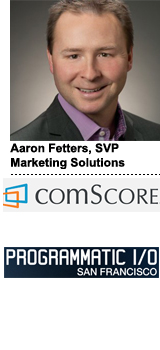 Aaron Fetters will discuss advancements (and present-day shortcomings) in data, ad delivery and effectiveness on April 14 at PROGRAMMATIC.IO in San Francisco.
Aaron Fetters will discuss advancements (and present-day shortcomings) in data, ad delivery and effectiveness on April 14 at PROGRAMMATIC.IO in San Francisco.
Advertisers question ad quality and the ability to activate “open” data across platforms in the programmatic space, but what’s being done about it?
First, marketers need to rethink the way they’ve traditionally tallied impressions, said Aaron Fetters, SVP of marketing solutions for comScore. “The digital industry needs to progress beyond this very blunt gross impression count,” he said, “which is today’s trading currency for digital.”
Fetters, who as a former CPG marketer for Kellogg and P&G believed in the efficacy of programmatic at the brand level, said campaign metrics need to go beyond time on site or number of pixels in view. More diverse measurements (and more data permeability between walled-garden platforms) are especially important when marketers have specific goals in mind.
For instance, when looking at the sales funnel, Fetters indicates “recency” is important – that is, the time between a consumer looking at an ad and when she purchased.
“But for a marketer to understand recency, you have to tie your own data to a mix of behavioral or purchased-based data sets,” Fetters said. “We’ve traded TV dollars based on TRPs since the beginning. We can get there for digital as well.”
Fetters spoke with AdExchanger.
AdExchanger: How has the transition from Kellogg to comScore gone?
AARON FETTERS: It’s been really fascinating to come to the data and measurement side of the space and get a peek under the hood. We got deep into data-driven marketing at Kellogg and I had background at P&G as well, but coming to this side I now get to speak to hundreds of brands and see where they’re at and where they need more data activation or applications to support their business objectives.
Did the industry reach a tipping point with the programmatic in-house trend, which involved marketers like Kellogg and Netflix?
The industry as a whole realized that going fully in-house with programmatic – and there’s different spectrums of bringing your capabilities in house – was really complicated. Many different skillsets are involved in making it happen. Everyone used to think the promise of programmatic was to mechanize everything and pull people out of the process, but the reality is, there’s a different role and mandate.
How did this affect the agencies? Was this part of the push for greater transparency?
As marketers started to realize what capabilities really are needed for programmatic marketing, the agencies were shifting to make sure their talent lined up with skill sets that were needed. Marketers [were figuring out] if they should invest all their resources into programmatic, own a strategic part of it or contract with their agency, and still rely on other components of the industry to deliver on programmatic. In theory, they’d like to do more themselves, but the reality is everything from ad ops to billing – there’s a tremendous amount of work to be done. And oh, by the way, just trying to keep up with who’s who in third-party data providers takes tremendous effort.
How will shopper marketing change? Will more retailers open up their data sets?
I think it’s in the very early stages right now and some of these early movers [like Walmart and Amazon] are building a road map for other players down the road for how this is going to need to come together. It gets down to what data is most informative about consumers and shoppers, and how that data [can be used to] create an impact. And was that a shopper-based message or a brand-based message and did it happen in-store? We’re in the early stages, but I’d say I expect the bigger players – Oracle, Adobe, etc. – to bring all the assets together to command brand and shopper dollars.
What’s comScore’s role in all of this? Rather than owning a data management platform, you’ve attached to this open-platform concept.
ComScore will always be an independent, third-party measurement provider. That’s our role in the ecosystem: to help measure audiences and advertising for both the buy and sell sides. You only build a comprehensive measurement system through the acquisition of massive amounts of data assets, be it in the digital space and now post-merger with Rentrak in the television space. We’ve amassed the largest asset of single-source content consumption behavior across desktop, mobile, tablet devices. With that being the case, we are not looking to be in the game of selling media directly ourselves, so we’ve not bought a DMP or a DSP where we’d activate that data firsthand. But there’s tremendous value in some of the data we can bring to the table for DMPs to activate off of.
Will data eventually permeate the walled gardens like Facebook, Google, Amazon?
The industry will eventually demand that. I can say that coming from my role as a large marketer that at the time, we were demanding it. There is the desire to be able to look across my entire media buy. The problem is the sensitivity to that desire only increases as more dollars move into the digital space. As more consumption happens on over-the-top devices and nontraditional, linear TV, can you imagine if all the different OTT devices began to wall up their own data? It’d be a disaster.
What happens then?
I think the walls will begin to open up and it will take pressure from a few different places to make that happen. But I see it beginning to happen and I think marketers want one view into their total advertising performance. That doesn’t mean there needs to be one measurement provider. But those providers need access to all of the same data to understand how effective your advertising is. DMPs cannot operate today within the walled gardens you mentioned. Some of these platforms and solutions are fantastic for reach, but we need to make them applicable across an entire media buy and not portions of a media buy.
Some studies have indicated that time spent on ads and not percentage of pixels in view ultimately determines their effectiveness. Do you agree?
To go beyond that, this is where different marketers can have competitive advantage. When you hear about brands who use metrics like time on site to understand what’s driving volume or a human behavior you want, then that’s what you want to optimize your buy against. One of our lead researchers performed a study that showed it’s not necessarily about time on screen or even pixels on screen, but the recency in relation to the time of purchase. This idea is game-changing and requires you bring various data sets together to [power that capability in] programmatic marketing.












